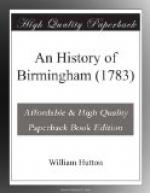It was the general practice of the Pagan church to fix their altar, upon which they sacrificed, in the East, towards the rising sun, the object of worship.
The Christian church, in the time of the Romans, immediately succeeded the Pagan, and scrupulously adopted the same method; which has been strictly adhered to.
By what obligation the Christian is bound to follow the Pagan, or wherein a church would be injured by being directed to any of the thirty-two points in the compass, is doubtful. Certain it is, if the chancel of Bartholomew’s had tended due East, the eye would have been exceedingly hurt, and the builder would have raised an object of ridicule for ages. The ground will admit of no situation but that in which the church now stands. But the inconsiderate architect of Deritend chapel, anxious to catch the Eastern point, lost the line of the street: we may therefore justly pronounce, be sacrificed to the East. Other enormities also, of little moment, have issued from the same fountain.
The altar piece was the gift of Basil Earl of Denbigh; and the communion plate, consisting of 182 ounces, that of Mary Carless. Income 100_l_.—Rev. William Jabbitt, chaplain.
[Illustration: St. Mary’s Chapel.]
SAINT MARY’s.
Though the houses for divine worship were multiplied in Birmingham, yet the inhabitants increased in a greater proportion; so that in 1772 an act was obtained for two additional chapels.
St. Mary’s, therefore, was erected in 1774, in the octagon form, not overcharged with light nor strength; in an airy situation and taste, but shews too little steeple, and too much roof. If a light balustrade was raised over the parapet, with an urn in the centre of the roof, the eye of the observer would be relieved.
The clock was seldom seen to go right, but the wonder ceases if there are NO WORKS within.
The land was the gift of Mary Weaman, in whom is the presentation, who inducted the Rev. John Riland. Annual income about 200_l_.
SAINT PAUL’S.
The act was procured for this chapel at the same time as for that of St. Mary’s; but it was not erected till 1779, upon a spot of ground given by Charles Colmore, Esq; upon the declivity of a hill, not altogether suitable for the elegant building it sustains, which is of stone—plain beauty unites with strength.
This roof, like that of St. Mary’s, appears also too full. The steeple intended for this useful edifice, will do honour to the modern stile of architecture, whenever money can be procured to erect it; which at present is only delineated upon paper.
Chaplain, the Rev. William Toy Young.—Income nearly as St. Mary’s.




